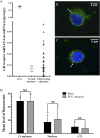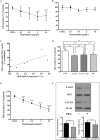In vitro impact of pegvisomant on growth hormone-secreting pituitary adenoma cells
- PMID: 27267119
- PMCID: PMC5064756
- DOI: 10.1530/ERC-16-0140
In vitro impact of pegvisomant on growth hormone-secreting pituitary adenoma cells
Abstract
Pegvisomant (PEG), an antagonist of growth hormone (GH)-receptor (GHR), normalizes insulin-like growth factor 1 (IGF1) oversecretion in most acromegalic patients unresponsive to somatostatin analogs (SSAs) and/or uncontrolled by transsphenoidal surgery. The residual GH-secreting tumor is therefore exposed to the action of circulating PEG. However, the biological effect of PEG at the pituitary level remains unknown. To assess the impact of PEG in vitro on the hormonal secretion (GH and prolactin (PRL)), proliferation and cellular viability of eight human GH-secreting tumors in primary cultures and of the rat somatolactotroph cell line GH4C1. We found that the mRNA expression levels of GHR were characterized in 31 human GH-secreting adenomas (0.086 copy/copy β-Gus) and the GHR was identified by immunocytochemistry staining. In 5/8 adenomas, a dose-dependent inhibition of GH secretion was observed under PEG with a maximum of 38.2±17% at 1μg/mL (P<0.0001 vs control). A dose-dependent inhibition of PRL secretion occurred in three mixed GH/PRL adenomas under PEG with a maximum of 52.8±11.5% at 10μg/mL (P<0.0001 vs control). No impact on proliferation of either human primary tumors or GH4C1 cell line was observed. We conclude that PEG inhibits the secretion of GH and PRL in primary cultures of human GH(/PRL)-secreting pituitary adenomas without effect on cell viability or cell proliferation.
Keywords: GH4C1; acromegaly; pegvisomant; pituitary adenoma; prolactin.
© 2016 Society for Endocrinology.
Figures




Similar articles
-
In Vitro Head-to-Head Comparison Between Octreotide and Pasireotide in GH-Secreting Pituitary Adenomas.J Clin Endocrinol Metab. 2017 Jun 1;102(6):2009-2018. doi: 10.1210/jc.2017-00135. J Clin Endocrinol Metab. 2017. PMID: 28323931
-
Somatostatin receptor subtype 1 selective activation in human growth hormone (GH)- and prolactin (PRL)-secreting pituitary adenomas: effects on cell viability, GH, and PRL secretion.J Clin Endocrinol Metab. 2003 Jun;88(6):2797-802. doi: 10.1210/jc.2002-021825. J Clin Endocrinol Metab. 2003. PMID: 12788890
-
Somatostatin Receptor Expression in GH-Secreting Pituitary Adenomas Treated with Long-Acting Somatostatin Analogues in Combination with Pegvisomant.Neuroendocrinology. 2017;105(1):44-53. doi: 10.1159/000448429. Epub 2016 Jul 25. Neuroendocrinology. 2017. PMID: 27455094 Free PMC article.
-
Diagnosis and treatment of pituitary adenomas.Minerva Endocrinol. 2004 Dec;29(4):241-75. Minerva Endocrinol. 2004. PMID: 15765032 Review.
-
Growth hormone-secreting adenomas: pathology and cell biology.Neurosurg Focus. 2010 Oct;29(4):E2. doi: 10.3171/2010.7.FOCUS10169. Neurosurg Focus. 2010. PMID: 20887127 Review.
Cited by
-
Genomics and Epigenomics of Pituitary Tumors: What Do Pathologists Need to Know?Endocr Pathol. 2021 Mar;32(1):3-16. doi: 10.1007/s12022-021-09663-4. Epub 2021 Jan 12. Endocr Pathol. 2021. PMID: 33433883 Review.
-
Prolactin and Growth Hormone Signaling and Interlink Focused on the Mammosomatotroph Paradigm: A Comprehensive Review of the Literature.Int J Mol Sci. 2023 Sep 12;24(18):14002. doi: 10.3390/ijms241814002. Int J Mol Sci. 2023. PMID: 37762304 Free PMC article. Review.
-
GH Action in Prostate Cancer Cells Promotes Proliferation, Limits Apoptosis, and Regulates Cancer-related Gene Expression.Endocrinology. 2022 May 1;163(5):bqac031. doi: 10.1210/endocr/bqac031. Endocrinology. 2022. PMID: 35383352 Free PMC article.
-
Octreotide and Pasireotide Combination Treatment in Somatotroph Tumor Cells: Predominant Role of SST2 in Mediating Ligand Effects.Cancers (Basel). 2021 Apr 10;13(8):1816. doi: 10.3390/cancers13081816. Cancers (Basel). 2021. PMID: 33920241 Free PMC article.
-
The role of combination medical therapy in the treatment of acromegaly.Pituitary. 2017 Feb;20(1):136-148. doi: 10.1007/s11102-016-0737-y. Pituitary. 2017. PMID: 27522663 Review.
References
-
- Atkin SL, Landolt AM, Foy P, Jeffreys RV, Hipkin L, White MC. 1994. Effects of insulin-like growth factor-I on growth hormone and prolactin secretion and cell proliferation of human somatotrophinomas and prolactinomas in vitro. Clinical Endocrinology 41 503–509. (10.1111/j.1365-2265.1994.tb02582.x) - DOI - PubMed
-
- Bassetti M, Spada A, Arosio M, Vallar L, Brina M, Giannattasio G. 1986. Morphological studies on mixed growth hormone (GH)- and prolactin (PRL)-secreting human pituitary adenomas. Coexistence of GH and PRL in the same secretory granule. Journal of Clinical Endocrinology and Metabolism 62 1093–1100. (10.1210/jcem-62-6-1093) - DOI - PubMed
-
- Berelowitz M, Szabo M, Frohman LA, Firestone S, Chu L, Hintz RL. 1981. Somatomedin-C mediates growth hormone negative feedback by effects on both the hypothalamus and the pituitary. Science 212 1279–1281. - PubMed
-
- Bernabeu I, Alvarez-Escolá C, Quinteiro C, Lucas T, Puig-Domingo M, Luque-Ramírez M, de Miguel-Novoa P, Fernandez-Rodriguez E, Halperin I, Loidi L, et al. 2010. The exon 3-deleted growth hormone receptor is associated with better response to pegvisomant therapy in acromegaly. Journal of Clinical Endocrinology and Metabolism 95 222–229. (10.1210/jc.2009-1630) - DOI - PubMed
MeSH terms
Substances
LinkOut - more resources
Full Text Sources
Other Literature Sources
Miscellaneous

